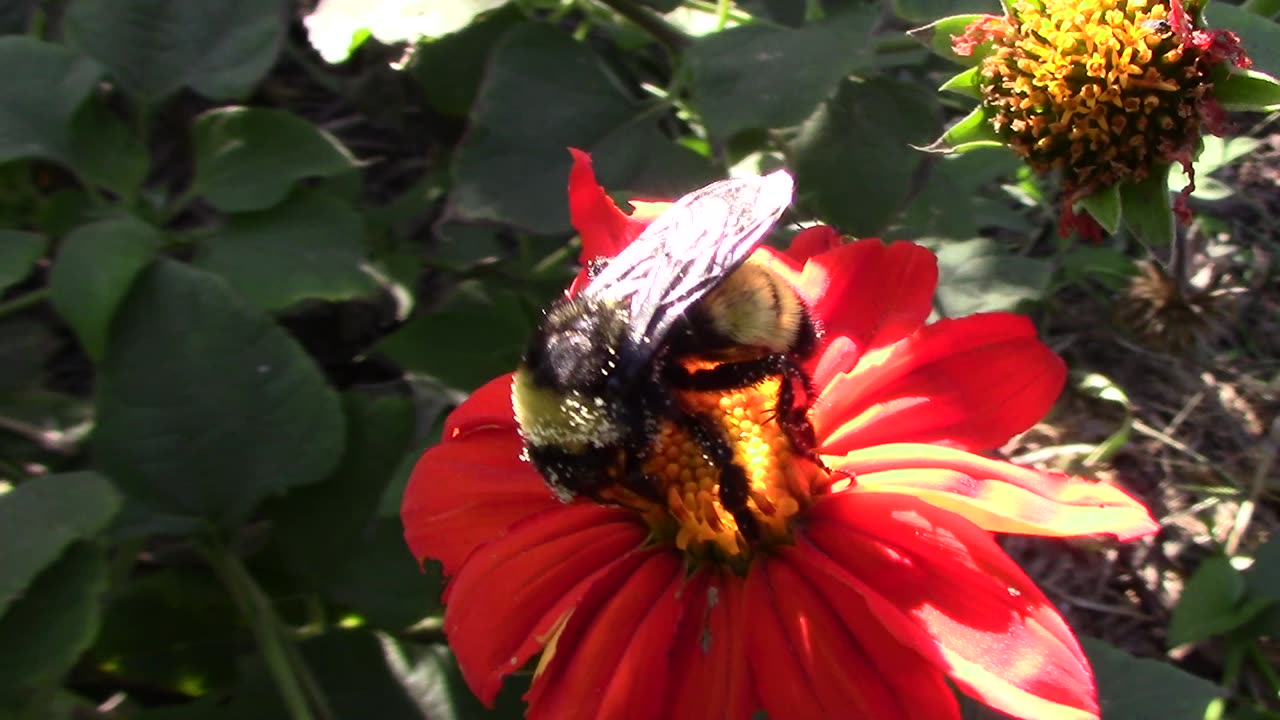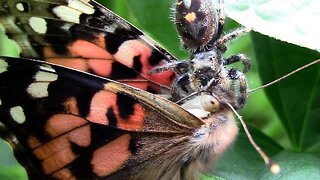Premium Only Content

What a Bumble Bee Sounds Like When It Takes Off
If you stand close enough to a Bumble Bee when it takes off, you can actually hear it's wings.
Appearance: Bumblebees are typically robust insects with rounded bodies covered in dense hair, which gives them a fuzzy appearance. They're often recognized by their black and yellow striped patterns, although some species may have orange or red markings instead of yellow.
Social Structure: Bumblebees are social insects, living in colonies typically consisting of a single queen, workers (females), and drones (males). The queen is responsible for reproduction, while workers gather food, care for the young, and maintain the nest. Drones mate with the queen, and their primary purpose is to fertilize new queens.
Life Cycle: Bumblebee colonies start in the spring when a mated queen emerges from hibernation. She establishes a nest, lays eggs, and raises the first brood of workers. As the colony grows, additional workers are produced. Towards the end of the season, the queen produces new queens and drones, which mate before the colony declines and the founding queen dies.
Pollination: Bumblebees are crucial pollinators, playing a significant role in the reproduction of many flowering plants, including numerous agricultural crops. They have specialized structures, such as long tongues and dense body hair, which enable them to efficiently collect and transfer pollen as they forage for nectar.
Behavior: Bumblebees are known for their distinctive buzzing sound as they fly, produced by the rapid beating of their wings. They are relatively docile compared to some other stinging insects, but they will defend their nests if they perceive a threat. However, they are not as aggressive as honeybees and typically only sting in self-defense.
Habitat and Distribution: Bumblebees are found primarily in temperate regions of the northern hemisphere, although some species inhabit higher elevations in tropical regions. They occupy a range of habitats, including meadows, forests, gardens, and agricultural landscapes.
Conservation: Like many pollinators, bumblebee populations face various threats, including habitat loss, pesticide use, climate change, and diseases. Conservation efforts aimed at protecting bumblebees and their habitats are essential for maintaining healthy ecosystems and ensuring the continued pollination of crops and wild plants.
My Nature Channel: https://rumble.com/c/ObservingNature
If you would like to create videos like I do, and monetize them, please use my referral link to register: https://rumble.com/register/MidwestGardener1
I will get a small percentage from Rumble's cut, then once you register, you can refer people too, and make a small percentage from their vides. It really is a great program.
-
 2:08
2:08
Observing Nature
4 months ago $0.25 earnedJumping Spider With a Butterfly
2942 -
 2:02:10
2:02:10
Inverted World Live
4 hours agoGhislaine Maxwell Gives 100 Names to DOJ | Ep. 81
149K15 -
 2:51:11
2:51:11
TimcastIRL
5 hours agoBREAKING: MASS SHOOTING ERUPTS In NYC, Police Officer SHOT, FBI On Scene | Timcast IRL
243K84 -
 LIVE
LIVE
ZWOGs
12 hours ago🔴LIVE IN 1440p! - EFT w/ crgoodw1n, Kingdom Come Deliverance, Splitgate 2, & More! - Come Hang Out!
1,284 watching -
 30:09
30:09
Afshin Rattansi's Going Underground
1 day agoCurtis Yarvin: ‘Trump 47 is 10x More Powerful than Trump 45’ & the TOXIC US-Israel Relationship
24.1K34 -

Drew Hernandez
9 hours agoTRUMP HINTS DEMS COULD HAVE PLANTED FAKE EVIDENCE & MANIPULATED EPSTEIN FILES
43.1K10 -
 LIVE
LIVE
Eternal_Spartan
12 hours agoThe Legend of Zelda: Majoras Mask Ep. 5 | USMC Vet | Come Join the Best Chat on Rumble!!!!
102 watching -
 3:44:24
3:44:24
Barry Cunningham
7 hours agoBREAKING NEWS: LIVE COVERAGE OF NEW YORK POLICE OFFICERS UNDER SIEGE!
88.9K66 -
 2:51:25
2:51:25
The Pascal Show
4 hours ago $1.71 earnedBREAKING! Active Shooter In Midtown Manhattan NYC Multiple People Shot!
19.3K2 -
 10:25
10:25
MattMorseTV
9 hours ago $11.42 earnedVance just DROPPED a NUKE.
38.8K41